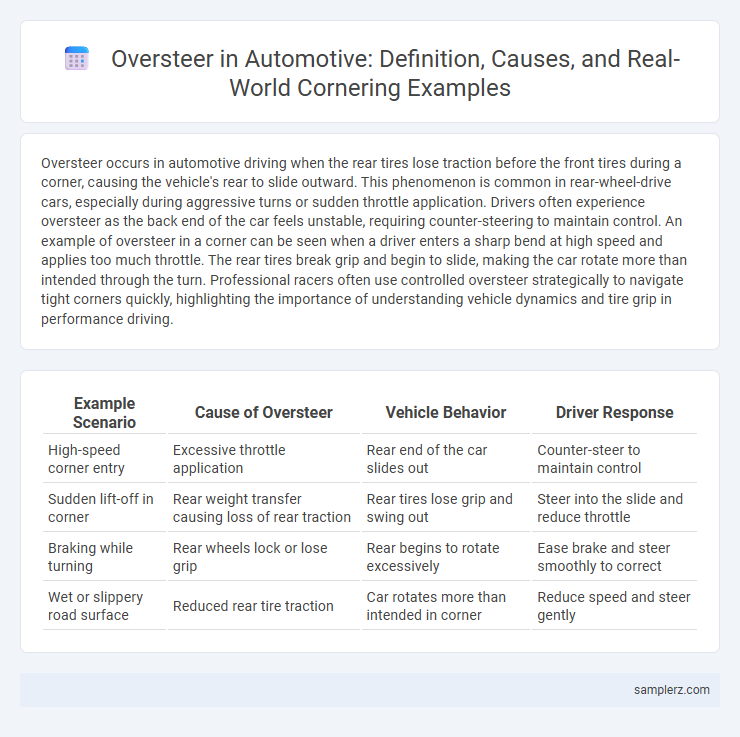Oversteer occurs in automotive driving when the rear tires lose traction before the front tires during a corner, causing the vehicle's rear to slide outward. This phenomenon is common in rear-wheel-drive cars, especially during aggressive turns or sudden throttle application. Drivers often experience oversteer as the back end of the car feels unstable, requiring counter-steering to maintain control. An example of oversteer in a corner can be seen when a driver enters a sharp bend at high speed and applies too much throttle. The rear tires break grip and begin to slide, making the car rotate more than intended through the turn. Professional racers often use controlled oversteer strategically to navigate tight corners quickly, highlighting the importance of understanding vehicle dynamics and tire grip in performance driving.
Table of Comparison
| Example Scenario | Cause of Oversteer | Vehicle Behavior | Driver Response |
|---|---|---|---|
| High-speed corner entry | Excessive throttle application | Rear end of the car slides out | Counter-steer to maintain control |
| Sudden lift-off in corner | Rear weight transfer causing loss of rear traction | Rear tires lose grip and swing out | Steer into the slide and reduce throttle |
| Braking while turning | Rear wheels lock or lose grip | Rear begins to rotate excessively | Ease brake and steer smoothly to correct |
| Wet or slippery road surface | Reduced rear tire traction | Car rotates more than intended in corner | Reduce speed and steer gently |
Understanding Oversteer in Automotive Dynamics
Oversteer occurs when the rear tires lose grip during cornering, causing the rear of the vehicle to swing outward and rotate more than intended. This phenomenon is often experienced in high-performance rear-wheel-drive cars when throttle input is excessive or traction is reduced on the rear axle. Understanding oversteer dynamics is crucial for tuning suspension setups and stability control systems to enhance vehicle safety and handling precision.
Typical Causes of Oversteer During Cornering
Oversteer during cornering often results from excessive throttle input, causing the rear wheels to lose traction and slide outward. Under-inflated rear tires or worn suspension components can also decrease rear grip, intensifying oversteer. Sudden steering inputs or braking while turning disrupt weight distribution, leading to instability and oversteer conditions.
Real-World Scenarios: Oversteer on Wet Roads
Oversteer on wet roads often occurs when a driver enters a corner too quickly, causing the rear tires to lose traction and slide outward, especially in rear-wheel-drive vehicles like the BMW M3 or Mazda MX-5. This loss of grip results in the rear end of the car rotating more than intended, challenging the driver's ability to maintain control. Real-world scenarios frequently involve sudden throttle adjustments or abrupt steering inputs that exacerbate oversteer, increasing the risk of spinouts or collisions on slick surfaces.
Rear-Wheel Drive Oversteer Example
Rear-wheel drive oversteer occurs when the rear tires lose traction during cornering, causing the rear of the vehicle to slide outward. A classic example is accelerating through a sharp turn in a sports car like the BMW M3, where power delivered to the rear wheels exceeds grip levels, resulting in the rear end stepping out. Proper throttle control and counter-steering techniques are essential to manage and correct oversteer in these scenarios.
How Excessive Speed Induces Oversteer in Corners
Excessive speed in corners causes the rear tires to lose traction, leading to oversteer as the rear end of the vehicle slides outward. This phenomenon occurs because the centrifugal force overcomes the grip of the rear tires, compromising vehicle stability and control. Drivers experiencing oversteer must counter-steer to correct the slide and maintain the intended trajectory through the curve.
Oversteer from Sudden Steering Inputs
Oversteer from sudden steering inputs occurs when a driver abruptly turns the steering wheel, causing the rear tires to lose traction and slide outward during cornering. This dynamic imbalance leads to a fishtail effect, commonly experienced in rear-wheel-drive vehicles with high power output. Proper throttle modulation and smooth steering corrections are essential to regain control and prevent spinouts in sharp turns.
Drifting: Controlled Oversteer Illustrated
Drifting exemplifies controlled oversteer, where the rear wheels intentionally lose traction while maintaining steering input to guide the car through a corner. This technique requires precise throttle modulation and counter-steering to balance the vehicle's dynamics, preventing a spin-out. High-performance rear-wheel-drive cars like the Nissan Silvia and Toyota Supra are popular choices for executing smooth, controlled drifts on race tracks.
Oversteer in Performance and Sports Cars
Oversteer in performance and sports cars occurs when the rear tires lose grip during cornering, causing the rear end to slide outward. This phenomenon is often exploited by skilled drivers to achieve faster cornering speeds and controlled drifts. Vehicles like the Nissan GT-R and Porsche 911 are engineered to manage oversteer, offering balanced handling and enhanced driving dynamics on track and road.
Oversteer Incident Analysis in Motorsports
Oversteer occurs when a race car's rear tires lose traction during a high-speed corner, causing the rear to slide outward and the vehicle to rotate more than intended. In motorsports, oversteer incidents often result from aggressive throttle application or abrupt steering inputs, leading to loss of control and potential spinouts. Analyzing telemetry data such as yaw rate, lateral acceleration, and steering angle helps engineers optimize vehicle setup and driver technique to mitigate oversteer risks on various track sections.
Preventing Oversteer While Cornering
Oversteer in cornering occurs when the rear tires lose grip, causing the vehicle's rear to slide outward and potentially spin. Preventing oversteer requires precise throttle control, smooth steering inputs, and maintaining optimal tire traction through proper suspension setup and tire pressure. Advanced stability control systems like Electronic Stability Control (ESC) actively detect and correct oversteer by selectively braking individual wheels and adjusting engine power.

example of oversteer in corner Infographic
 samplerz.com
samplerz.com